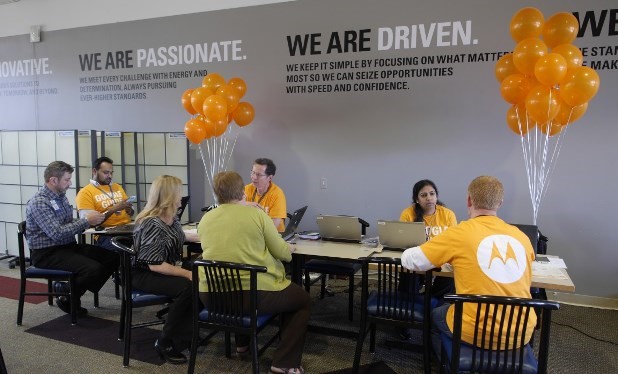Greg Meyers, CIO at Motorola Solutions since August 2014 recalls his job search approach and the interview strategy that won him the role.
Heller Search: Were you actively looking for a new CIO role?
Greg Meyers: Yes. I had already been a Divisional CIO and had spent the last five years as the number two at my previous company, and felt I was ready for my own shop.
How did you hear about the CIO opportunity at Motorola Solutions?
I have always maintained good connections with the executive recruiting community. As a result, once I started letting some of them know what I was looking for, I was in the mix for several good CIO jobs.
What piqued your interest in CIO opportunity at Motorola Solutions?
It’s an interesting connection, actually. A big part of Motorola Solutions’ business is providing communications products and services to public safety agencies, such as police and firefighters. For several years after college, I was a volunteer fireman. As a first responder, I actually experienced life threatening situations where my Motorola radio was the closest thing I had to a lifeline. So I was extremely familiar with the company and had a great deal of respect for their products as a result of those experiences years back.
Motorola Solutions is an 87 year old company. It has undergone many changes over the years and it is currently undergoing a major transformation from a product company into a software and services company.
|
“At the CIO level, I think you should go into interviews with your head clear rather than full of facts and figures. The most important thing is to be fully present.” |
As I learned more about this opportunity, I could see that, as CIO, I would play a significant role in transforming this legendary company that I already respected so much. I would have the chance to influence how their products get designed and delivered. That is not something most CIOs get to do.
What was it about your professional background that was attractive to Motorola Solutions?
I think the fact that during my career, I’ve spent just as much time in sales and marketing as in IT was attractive. I think they could see in my background that I am just as passionate about helping the business to win as I am about technology. Also, they felt that my years of experience in biotech, and the progressive, innovative IT culture of that industry, was something to leverage as the company undergoes this transformation.
How did you prepare for your interviews?
I read up a little on the corporate operations and listened to some investor presentations. But, at the CIO level, I think you should go into interviews with your head clear rather than full of facts and figures. The most important thing is to be fully present. If you are constantly thinking about what you are going to say next, you are not going to bring the kind of listening that people will be looking for in a confident executive.
Did you have an interview strategy?
I knew I was meeting with business people primarily, not IT. My goal was for many of them to walk out feeling that I was a well-rounded executive genuinely interested in their business, not someone that wants to only talk about IT.
Most executives believe that you wouldn’t be there if you weren’t qualified technically. What they want to know is what sort of person you are. What type of leader, and what impact will you have on the culture.
Was there a particularly memorable question or exchange that took place during your interviews?
I was impressed by how the CEOs questions were designed to probe me not as an IT or business leader, but as a human being. He asked questions in such a way that I couldn’t give a pat answer. I really had to take a powerful stand. When you are interviewing with a CEO for this type of leadership position, I think you really need to be prepared to speak from what you believe.
How did you prepare to start your new role?
I never worked harder than I did during those five weeks between the old job and the new one. I thought hard about the leadership I needed to bring, and the message I wanted to convey to both my team and the company as a whole about who I am and why I am here.
I developed a 100 day plan that was very carefully thought through. Essentially it was a playbook for all the things I wanted to learn and form opinions about in the first 100 days. It was organized by group: executive team, my leadership team, and staff.
Another thing I did during that time was reach out to old colleagues and mentors. I asked them, “If you had your first 100 days to do over again, what would you do differently?”
Who do you report to at Motorola Solutions?
The Chief Innovation Officer
From Day One, what are some of the concrete steps you took to learn the business and build relationships across the enterprise?
I held a town hall meeting on my second day at the company with the entire internal IT team – 300 people. I asked them to tell me what they thought we could be doing better. I handed out index cards and had everyone write down three ideas, to maximize participation. We immediately organized all of them into major themes and asked for people to volunteer to work on them in teams.
The biggest stack of index cards was about “career stagnation.” 15% of the IT staff were given new jobs within my first 100 days. Also in that time we announced the revised IT organizational structure and leadership team.
At one of our manufacturing facilities, I arranged to do an “undercover boss” day, disguised as a temp sent over from our staffing provider. Afterwards, I blogged about the experience. It really helped me learn about the business and I think it also showed people that I was truly interested in understanding how the company worked, in detail, and in finding ways to improve the company.
Lastly, in my first month, I spent a day with the Boston Police Department, watching how their 911 center worked and discussing with police officers how they use our products.
What significant technical changes have you made, or do you plan to make in the near future?
We just moved the entire company to Google Apps for Work—all 17,000 people in one day. It was a success only because we got the user population very engaged. There were 1,000 volunteer “Google Guides,” all company employees, spread out across every location whose calendars were cleared so they were available to help anyone with problems or questions about the new apps. They were wearing bright orange shirts and had orange balloons floating above their cubicles and outside their offices, so people knew where to find answers. (Photo above)
Up next are all the technologies behind the browser that our customers use. One third of our business happens via e-commerce. So we are working to digitize our entire front office, all our web technologies, and we are going to use Agile to do it.
How do you know when your IT organization is succeeding?
When shadow IT is dissipating and people are coming back to us as the preferred IT provider, I think that is one sign that we have strengthened our relationship with the business. Things have to move quickly and we need to be agile. It used to take 28 days to set up a virtual machine, but now it takes less than 10 minutes.
About Greg Meyers
 Greg Meyers is the CIO for Motorola Solutions where he is responsible for all IT world-wide. Prior to that, he was at Biogen, Novartis and Johnson & Johnson in various business and IT roles. Greg was awarded the Computerworld Top 100 leaders in IT award in 2013. He is a graduate of Temple University where he received his MBA and Rutgers University where he received a B.S. in Marketing.
Greg Meyers is the CIO for Motorola Solutions where he is responsible for all IT world-wide. Prior to that, he was at Biogen, Novartis and Johnson & Johnson in various business and IT roles. Greg was awarded the Computerworld Top 100 leaders in IT award in 2013. He is a graduate of Temple University where he received his MBA and Rutgers University where he received a B.S. in Marketing.
About Motorola Solutions
Motorola Solutions (NYSE: MSI) creates innovative, mission-critical communication solutions and services that help public safety and commercial customers build safer cities and thriving communities.



Add a Comment